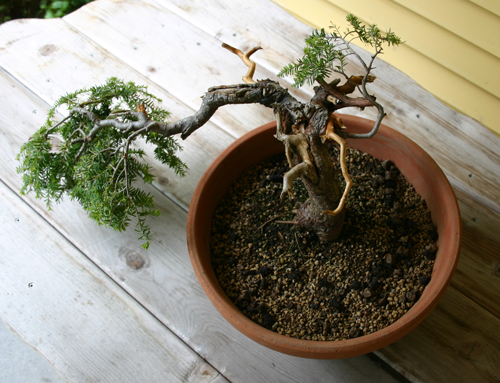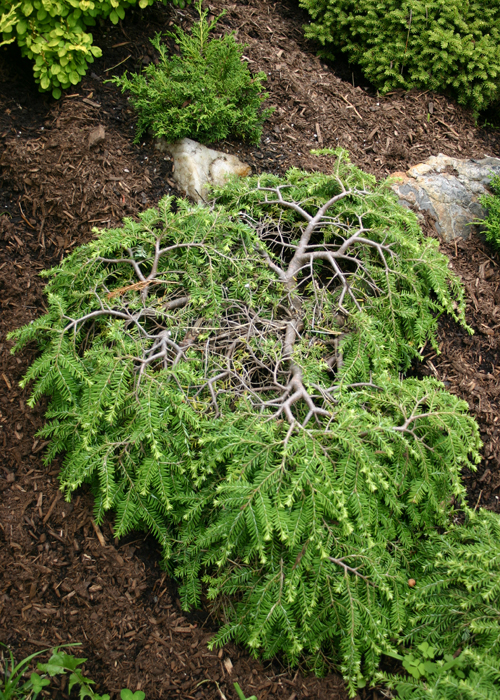
A Cole’s prostrate hemlock (Tsuga canadensis ‘Cole’s Prostrate’) that went from nursery container to my back yard and then into this growing pot (it’s now back in the ground, no photo yet). I cut off about 75% of the original. Some of the deadwood is new, but the more faded deadwood on the trunk was already there. Photo by Amy Palmer.
Old Cole’s prostrate hemlocks
A couple years ago I stumbled across eight amazing old Cole’s prostrate hemlocks in nursery pots at Palmer Koelb’s Baker Valley Nursery in New Hampshire (Palmer also owns Shin Boku Nursery). Palmer loves Okatsune tools, so we worked up a trade and I brought them home and stuck them in some landscaped areas around my house.

This little piece of my back yard features another Cole’s prostrate hemlock that hasn’t been dug yet (not quite as juicy as the one above). Meanwhile it looks pretty good as a landscape plant. The others plants are: Golden nugget dwarf barberry (upper left corner); Shimpaku juniper (upper center) Little gem spruce (upper right); A small piece of another shimpaku (peeking in on the right) and a piece of another Cole’s prostrate hemlock (lower right). The weeds in the lower left corner aren’t really there. Photo by Amy Palmer.
From pot to ground to pot to ground
It’s not that unusual to stick nursery stock in the ground to hasten development. What is a little unusual (though not unheard of) is to go from pot to ground to pot and then back into the ground.
Some pretty good reasons
One reason for sticking many of my partially trained trees back into the ground is that I don’t want to be bothered wintering too many trees in pots. We like to get out of Vermont some in the winter, and the risk is high when someone else is looking in on your trees. That, and it’s fun taking trees out of the ground and training them for a while and then putting them back to once again hasten their development.

Another shot of the tree in its bonsai training pot (from Japan). From this angle you can see that it has a future as a full cascade. The little crown at the top needs to develop, so I stuck it back into the ground (more later on this tree). Photo by Amy Palmer.
Hi Wayne,
The soil in the training pot appears to have a very high organic content, almost looks like potting soil? Could you share what it is, and what do you recommend for most trees in training? I am in an apartment, so I cannot grow in the ground.
Thanks,
Josh
Hi Josh,
That’s actually akadama (imported soil from Japan that is often used for conifers). The organic stuff you see on the surface is fertilizer pellets; two types: Bio-Gold (hard to get these days) and Green Dream (which we sell).
Apartments are a whole other thing. If you have to grow everything indoors, you should probably stick to tropical trees. We sell a mix designed for tropical bonsai and there are others on the market.
I hope this helps and good luck!
Thanks for the fast reply Wayne. I have a medium size porch, with about 15 trees on it right now. Most are japanese maple varieties. Will pure akadama work best for them, or do you think I should mix something else in? Thanks again!
You could use akadama for maples, though Japanese growers might object. I use it for most things I have in pots (not just conifers), including some deciduous trees, and find it works quite well. I like it because I know how it performs in terms of watering (pretty much everything dries out at the same rate) and feeding, and because I’m lazy. But that’s just me. There are no doubt some people out there that have better ideas on how to grow maples.
Hi guys
I live on the west coast, pacific north west, van isl. we throw trees back and forth from garden to pots all the time. Sometimes 2 years back and forth helps to energize especially if you are showing trees in smaller pots. We have an abundance of both low level hemlocks and mountain hemlocks and if ever want to fatten them up you must put them in the ground because the are very so to fatten in pots even if the pot is over sized. Hope that makes sense.
Happy bonsai
Brian
Hi Brian,
Thanks for the insights on your experience with Hemlocks.
BTW: I just noticed that you posted exactly the same comment on a Bark post from 2009. https://bonsaibark.com/2009/08/06/field-growing-8-old-coles-hemlocks/